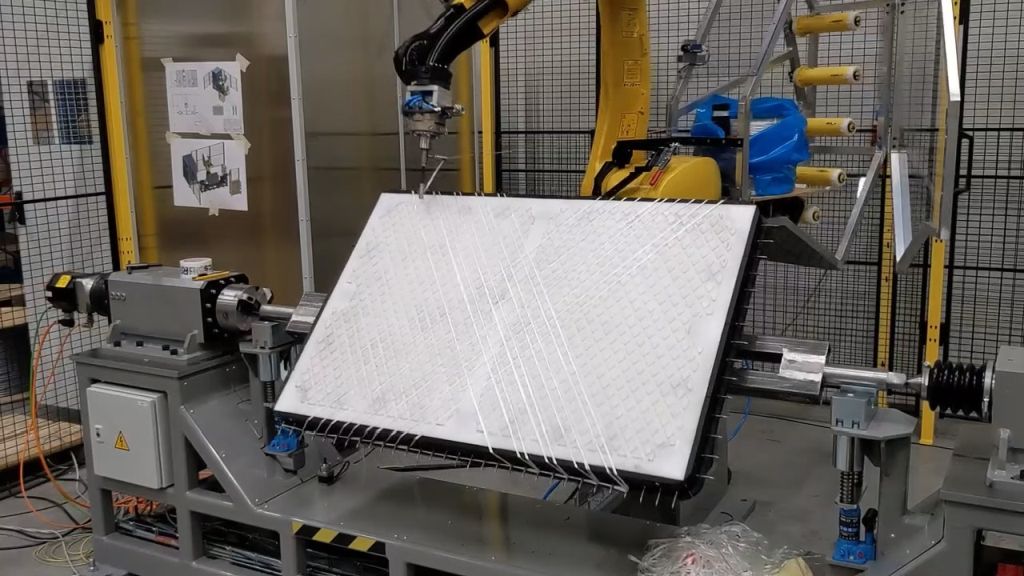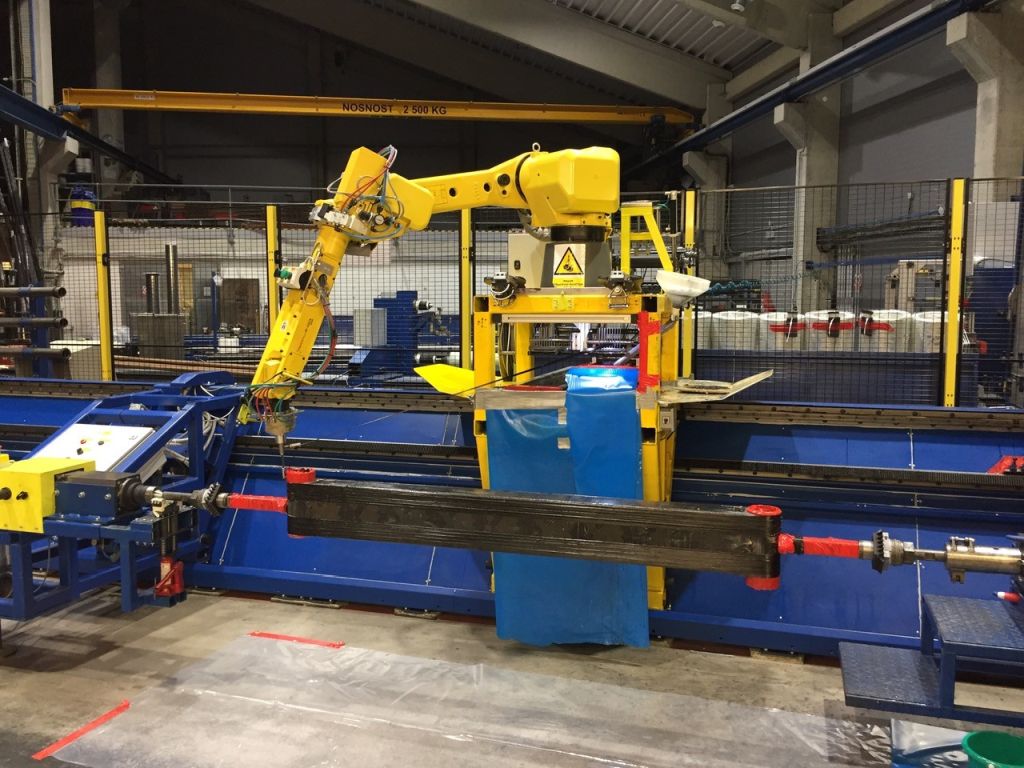Fit for purpose

CompoTech says its custom-built advanced winding technology machines are helping to open up new possibilities for industrial composite components.
With the growing need for automated production systems, CompoTech has expanded its business to offer custom-built ‘turnkey’ automated fibre winding and filament placement machines with a fully-integrated robot arm. The company says the incorporation of proprietary advanced winding technologies in its automated machines opens new possibilities for producing carbon fibre (CF) components.
A custom-built automated fibre winding and laying machine project, now installed and commissioned by CompoTech, is being used to develop a new lightweight, high strength CF epoxy composite Euro pallet. CompoTech’s automated robot winding machine was commissioned by a leading logistics company as part of ongoing investments to improve the sustainability of the business. The pallet - also developed by CompoTech - is replacing heavier metal pallets to reduce transportation costs and the carbon footprint of future deliveries.
The design of the bespoke automated winding pallet production machine includes a FANUC 6-axis robot with a specially designed ‘end of arm’ fibre delivery head tooling. The robot arm also provides automated tool changes and part loading/unloading. The capabilities of the new automated CF pallet making machine includes both CompoTech’s proprietary axial fibre winding technology and its Integrated Loop Technology which produces fixture-free joints. Both technologies were showcased at the recent JEC World exhibition.

All advanced winding machines produced by CompoTech are custom-built to meet individual customer needs and specifications. Individual machines are based on a standard platform. To meet specific customer requirements, automated production options available include Compo FixTool - fixed spindle and tailstock, Compo AdapTool - automatic tool length control up to 3m and Compo LinAx - for larger parts up to 12m, robot mounted on linear axis rails.
CompoTech turnkey winding machines include as standard, an integrated FANUC 6-axis robot arm, along with in-house developed ‘Shneg’ fibre placement and winding software that controls the robot arm and winding mandrel. The software converts a design specification into a production programme to precision manufacture a CF component.
Standard program preparation winding codes for producing common types of products, such as round tubes, beams and n-edge profiles, come with all machines; the codes provided cover the key production parameters, including diameter, length, and number of pins, sides and spindles, making it easy to either program a new product or to make program adjustments to an existing component. The standard production program codes provided by CompoTech include: Winding of axis-oriented layers; Winding of crossed layers; Tangential wrapping with definable pitch; Rolling of n-edge profiles.
Built-in performance
In comparison to existing conventional winding machines, CompoTech’s automated winding machine system is said to be more efficient and enables parts to be made using less fibres/materials. The system also provides a high degree of flexibility which enables component producers to choose to optimise the mechanical properties of a component when high performance is needed, or to maximise productivity by optimising part production at a higher production speed. Where needed, the winding machine can also be programmed to create, strong, continuous fibre, integrated loop joints, avoiding the need for drilling or fixtures.
CompoTech’s winding and fibre placement techniques result in the production of composite beams and tubes with 10-15% higher stiffness in the axial direction and up to 50% greater bending strength compared to a conventional filament wound beam with the same dimensions. The placement technology is also refined to use graphite ‘Pitch’ as well as PAN carbon fibres. Continuous fibres can be accurately placed axially along the length of a CF epoxy composite component - for example in square beams for industrial applications. Standard square beams, supplied to customers to replace a steel or aluminium beam, have been produced in a range of sizes from a 60mm x 60mm x 5mm wall thickness beam weighing only 1.7kg/m, up to the largest beam size of 200mm x 200mm x 8mm, weighing 4.2kg/m. These achieve E Modulus of 210GPa, matching tool steel, but it’s also possible to increase the axial fibres to get up to two times higher stiffness.

The stiffness and bending strength achievable by CompoTech’s carbon composite beams has enabled modular industrial tooling system producers, such as Bilsing Automation, to replace much heavier steel and aluminium beams, providing significant production benefits, such as faster operating speeds and higher productivity, less vibration and more rapid damping, heavier load handling capabilities on the same line and lower energy consumption and lifetime operating costs.
“We know from customer feedback that our advanced winding machines and technology provides optimal composite laminate production capabilities and flexibility that other filament winding machines, or even other processes, cannot offer,” explains CompoTech’s head of business development, Dr Humphrey Carter. “Now we can share this technology with our customers, whilst also working with them to develop the composite parts and design that can be manufactured most efficiently.
“By moving the business into automated machine building, manufacturers now have the opportunity to order and have installed in-house a custom-built automated production facility that can make carbon composite components with the mechanical properties, weight and cost-saving benefits that CompoTech achieves with the components we produce for our customers.”
Robot technology partnership
Key to making CompoTech’s new winding machine production business a reality was securing a robot technology partnership with FANUC for the robot system hardware, and ARC-Robotics for the service support. The key shopfloor workspace specification parameters of the FANUC robot machine are: Adjustable mandrel length: 390mm to 3,628mm; Maximum product length: 3,200mm (robot reach); Maximum winding diameter on one axis: 500mm; Maximum winding diameter on three axes: 150mm; Maximum mandrel weight: 150kg.
To enable manufacturers to get the most out of their automated winding machines, CompoTech developed the Shneg 2.0 control program to be a very user-friendly software interface system, with an emphasis on ease and speed of editing the winding input parameters. The Shneg 2.0 is the master operation program for all machine motion control, which is fully-integrated with FANUC’s standard machine safety circuit software.
The Shneg 2.0 software provides three user interface display modes: ‘Normal’ used by an operator to select the program needed; ‘Technology’ used to change the parameters; ‘Advanced’ for programming and debugging new code. A major advantage for operators is that the Shneg 2.0 control system does not require compilation or modification of the input data, making it very easy to transition between products, thus reducing downtimes.
Several innovation projects are currently being worked on by the CompoTech, which includes potential new developments in both the production automation, and new design CF composite components that will need bespoke winding machines for OEMs and Tier 1 specialist producers. The R&D team is looking at various advanced materials to process from the latest in resin technology and towpreg/thermoplastic tape placement to manufacture next generation products, such as ‘linerless’ hydrogen tanks for applications, such as energy storage, aviation, HGVs, and mass transportation.








